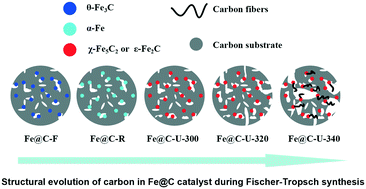Structural evolution of carbon in an Fe@C catalyst during the Fischer–Tropsch synthesis reaction
Abstract
A pseudo-in situ research method was applied to provide insight into the structural evolution of carbon in an Fe@C catalyst at different stages of the Fischer–Tropsch reaction. Five typical stages of the catalyst were selected for in-depth structural investigation; these were: the fresh catalyst, reduced catalyst, and catalyst in the stable conversion period, in an increased-conversion period and at the inactivation stage. The results indicated that the integral structure of Fe@C constantly changed in the Fischer–Tropsch reaction. Iron carbide transformed from the Fe phase that was easily oxidized under high temperature Fischer–Tropsch conditions, and the carbon framework was completely destroyed in the reaction process, leading to a drastic decrease in the specific surface area of the material. This destruction could have two opposing effects: on the one hand, the loss of carbon could re-expose the active sites that have been covered by carbon at a reaction temperature of 320 °C and favor the reaction; on the other hand, the deposition of carbon could block the active sites and lead to inactivation when the reaction temperature is over 340 °C.
////////Fischer–Tropsch














Sorry, the comment form is closed at this time.